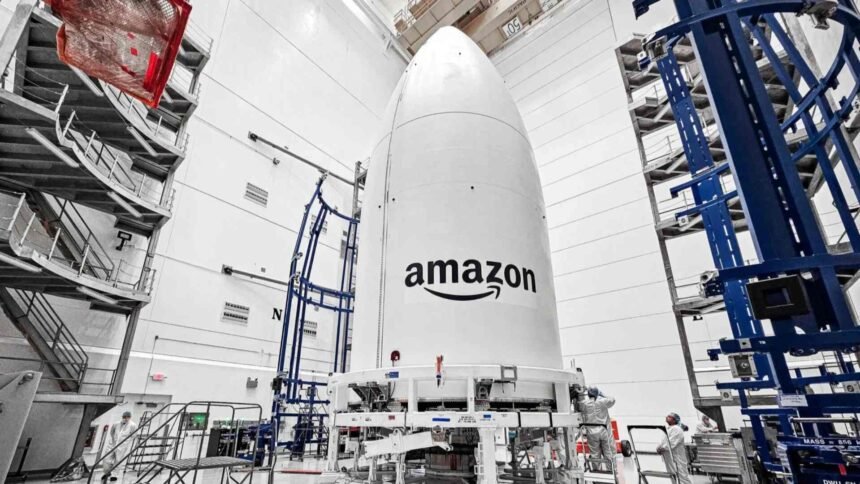With the liftoff at 2:18 a.m. EDT from Cape Canaveral, dubbed the KF‑01 mission, Amazon officially brought SpaceX into its constellation deployment strategy. These 24 satellites are the third batch of Kuiper satellites to reach space—following two previous Atlas V missions—and represent Amazon’s first collaboration with SpaceX for launching Kuiper payloads.
This historic partnership is the culmination of a December 2023 agreement in which Amazon secured three dedicated Falcon 9 flights alongside its earlier contracts with ULA, Arianespace, and Blue Origin.
Why This Amazon SpaceX Collaboration Matters
- Lower launch costs and faster deployment
SpaceX has revolutionized launch affordability with reusable rockets. For Amazon, turning to Falcon 9 makes logistical and financial sense as it races to deploy over 3,200 satellites by late 2025 and meet FCC licensing requirements by July 2026. - Strategic pressure on Starlink
Starlink, with over 6 million subscribers and roughly 9,000 satellites in orbit, currently dominates the market. The Amazon-SpaceX collaboration signals serious competition, injecting pricing power and innovation into the satellite broadband race. - Fulfillment of regulatory milestones
Per its FCC mandate, Amazon must have at least half of its constellation orbital by July 30, 2026. With this launch, Amazon now has 78 Kuiper satellites aloft—progress it can’t afford to stall.
The KF‑01 Mission: Breaking It Down
- Launch vehicle: Falcon 9 Block 5 booster B1096, flying its first-ever mission, successfully flew and landed on the droneship. A shortfall of gravitas about 8.5 minutes post-launch.
- Deployment: 24 satellites successfully released approximately 56 minutes into flight, in a 289-mile LEO orbit, later rising to target altitudes of about 630 km.
- Weather: Forecasts reported an 80% chance of favorable conditions, with thunderstorms over the Gulf Stream posing minor risks.
The Bigger Picture: Project Kuiper & the Competitive Arena
Founded in 2019 and backed by a $23 billion investment plan, Project Kuiper is Amazon’s bold bid to close the satellite broadband gap, targeting rural and underserved regions. With FCC approval to launch 3,236 satellites across multiple orbital shells, Amazon aims to offer services by late 2025, with tiers ranging from 100 Mbps to 1 Gbps.
Analysts envision up to $7 billion in annual consumer revenue by 2032, drawing from approximately 7 million subscribers at $80/month. Wall Street sees this as compelling, though BofA cautions on the heavy upfront costs and slim margins in early years.
Clash of Titans: Starlink vs. Kuiper
Starlink (SpaceX)
- ~9,000 satellites deployed, 6 million subscribers
- Proven reusable launch system, driving down operating costs
- Positioned as a geopolitical power tool (e.g., Ukraine connectivity)
Project Kuiper (Amazon)
- 78 satellites now in orbit, with aggressive rollout ahead
- Strategic mix of launch partners, now including SpaceX
- Strong financial backing and integration with AWS and logistics
What’s Next for Kuiper?
- Next launches: Two more Falcon 9 launches are scheduled under the SpaceX contract later this year. Other vehicles, including ULA’s Vulcan, Arianespace’s Ariane 6, and Blue Origin’s New Glenn, will continue their own mission schedules.
- Service rollout: Amazon aims to launch commercial service by late 2025, with three-tiered antenna offerings to cater to diverse customer needs, from residential to enterprise.
- Edge over Starlink: Kuiper’s built-in AWS connectivity, future IoT integration, and e-commerce logistics capabilities may offer unique advantages .
Final Take: What This Means for Consumers & Investors
- Consumers: A true multi-provider future in satellite internet more pricing options, faster speeds, and expanded coverage in remote areas.
- Investors: Enormous growth potential locked behind high up-front spending and stiff competition. Still, Kuiper adds an exciting growth dimension to Amazon’s already robust portfolio.
- Space Industry: The Amazon-SpaceX collaboration breaks old rivalries and accelerates satellite deployment momentum. This shift could redefine how multi-billion-dollar space projects are managed.
The Amazon SpaceX collaboration on the KF‑01 mission is nothing short of groundbreaking. It merges the strengths of two industry giants, challenging Starlink’s dominance and speeding up the rollout of global satellite connectivity. With 78 Kuiper satellites in orbit and more on the way, the satellite internet landscape is now wider and more competitive.
For tech enthusiasts, space watchers, and investors, this isn’t just a launch; it’s the dawn of a new era in broadband internet.






